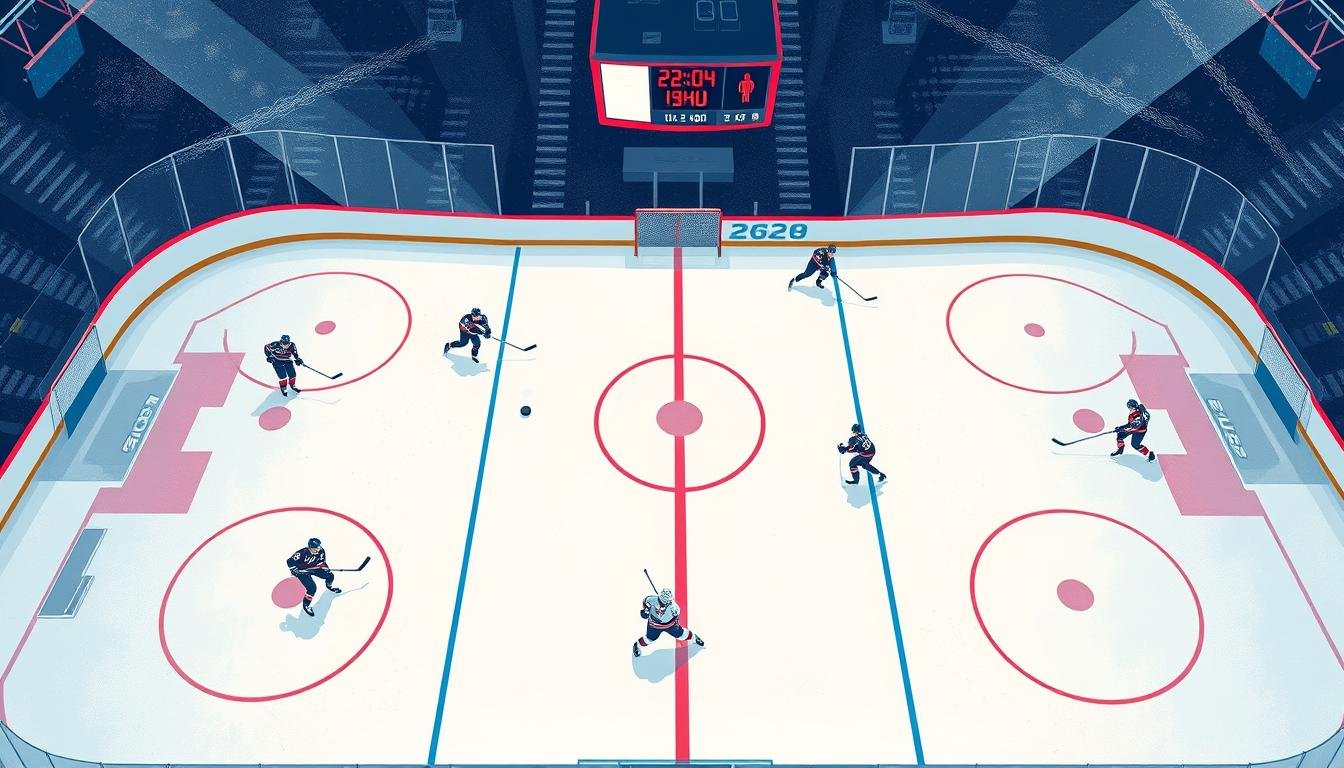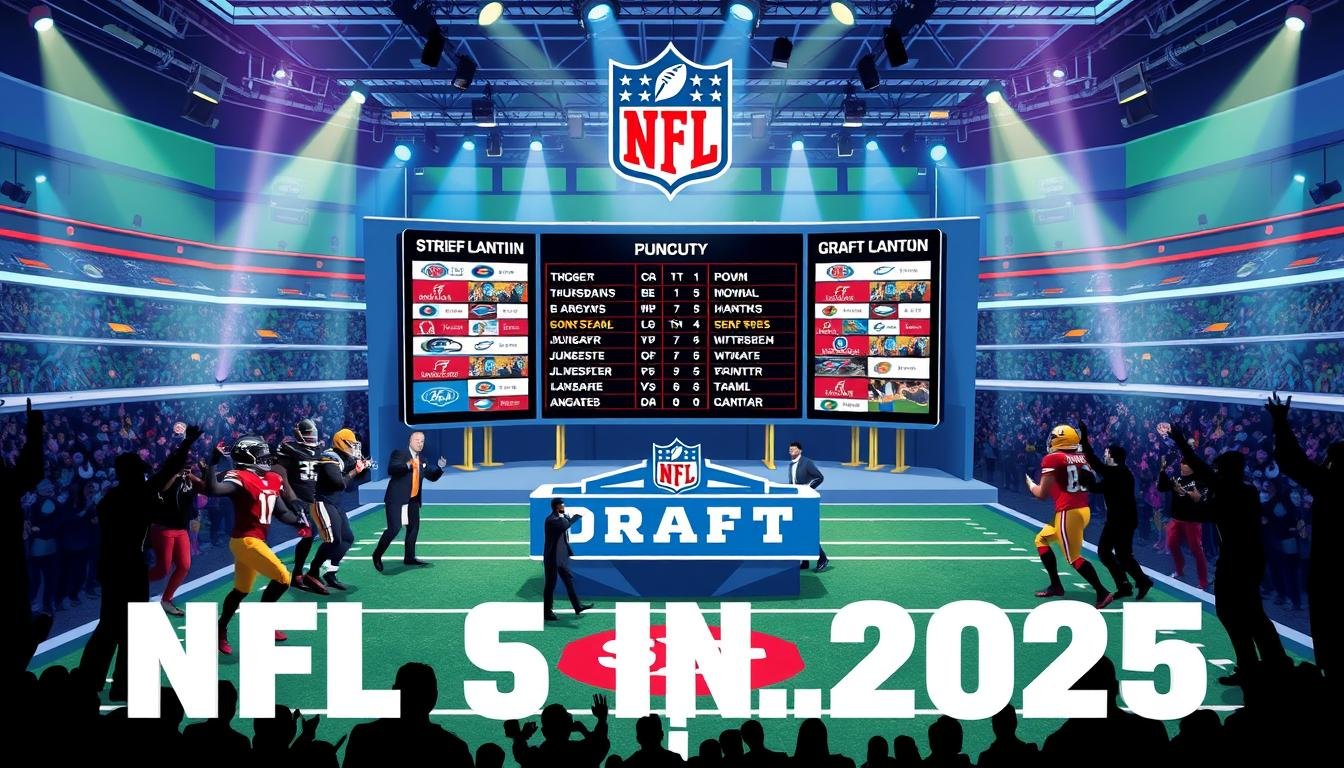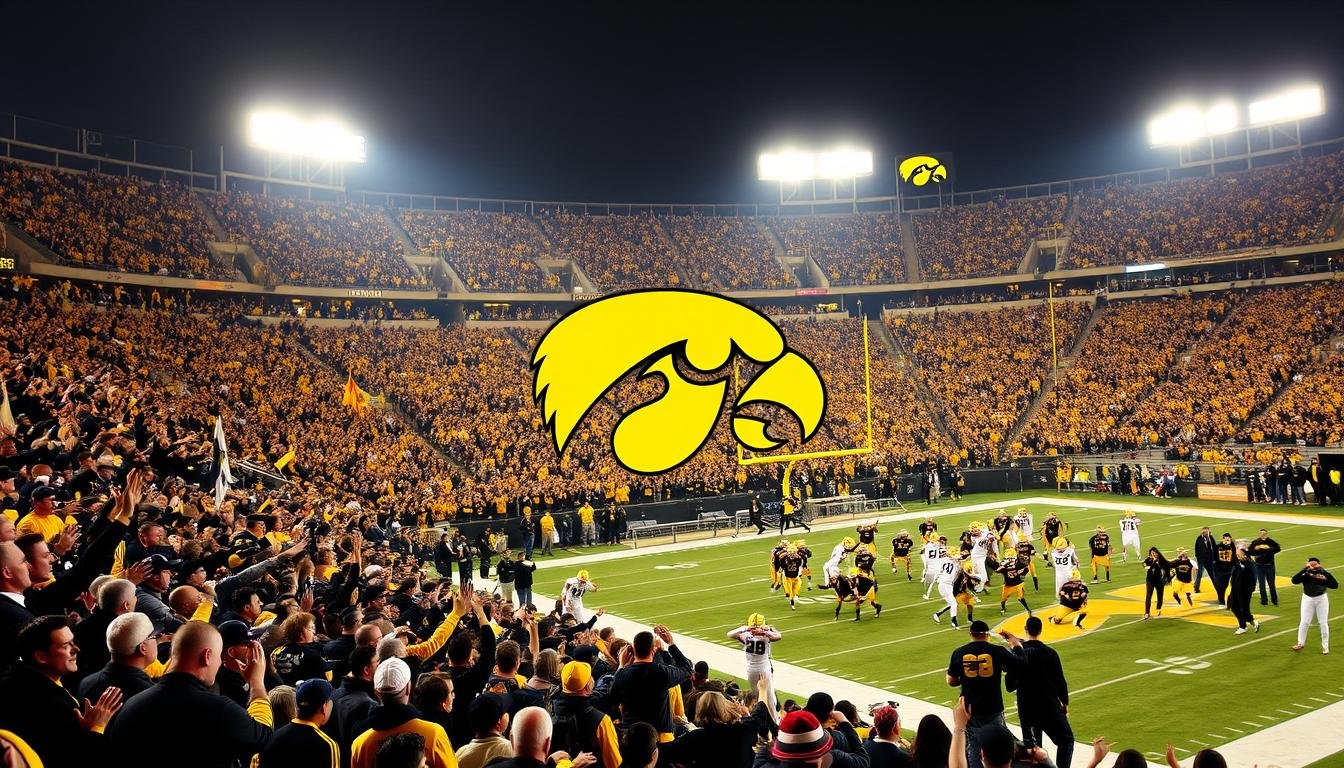Table of Contents Show
A hockey game is split into periods. Knowing the structure is key to enjoying the game. Most games have three periods, but some leagues have different rules.
To find out how many periods are in hockey, we need to look at the game’s structure. The National Hockey League (NHL) and other top leagues stick to the three-period format. But, there are some exceptions.
The game’s structure aims to make it fair and exciting for everyone. The number of periods can change the game’s strategy and speed. In this article, we’ll dive into the standard format and any variations. We’ll also cover the rules for periods in different leagues.
Key Takeaways
- The standard hockey game consists of three periods.
- The length of each period can vary depending on the league and level of play.
- Understanding the hockey game structure is essential to appreciating the game.
- The number of periods in a hockey game can affect the strategy and pace of the game.
- Different leagues have variations in their period formats and rules.
- The hockey game structure is designed to provide a fair and exciting experience.
- Knowing how many periods in hockey is key to grasping the game’s dynamics.
Basic Structure of a Hockey Game
Hockey games are set up to be thrilling for both players and fans. The game is split into periods, each lasting a certain time. Knowing about regulation time in hockey helps fans see the game’s strategy and speed.
The most common game structure is three periods. This setup balances player endurance, strategy, and fan interest. Breaks between periods let teams rest and change their plans, while fans enjoy the downtime and look forward to the next action.
Standard Three-Period Format
Typically, each period in a hockey game lasts 20 minutes, with 15-minute breaks in between. This makes the game around 60 minutes long, not counting overtime. The regulation time is managed to make the game fair and exciting.
Historical Development of Period System
The period system in hockey has changed over the years. Early games had just one long period. As the game grew more popular and demanding, breaks and multiple periods became necessary. Now, most leagues use the standard three-period format, making games consistent and thrilling for everyone.
Purpose of Multiple Periods
The multiple-period structure has several benefits. It lets players rest and recover, allows for strategic changes, and keeps fans interested. By understanding the game’s structure and regulation time, fans can better enjoy the excitement of each period.
How Many Periods in Hockey: The Standard Format
A standard hockey game has three periods, each lasting 20 minutes in professional leagues. This setup is common in most leagues, making the game structure clear for everyone. The hockey match duration is split into these three periods, with breaks in between.
When you ask how many periods in hockey, the answer is usually three. But, there can be special cases or changes to this rule. We’ll talk about those later. For now, it’s important to know the standard format aims to make the game fair and fun for everyone.
Here are some key points about the standard hockey period format:
- Each period lasts 20 minutes in professional leagues
- There are three periods in a standard hockey game
- Intermissions are taken between periods to allow teams to rest and strategize
The three-period format gives a clear structure to the hockey match duration. Knowing how many periods in hockey helps fans understand the game’s strategy and pace. As we dive into hockey, it’s clear the standard format is key to the game’s excitement.
| Period | Duration |
|---|---|
| 1st Period | 20 minutes |
| 2nd Period | 20 minutes |
| 3rd Period | 20 minutes |
Length of Hockey Periods
The time for hockey periods changes with the level of play. In the National Hockey League (NHL), each period lasts 20 minutes. This is the standard for most professional and amateur leagues.
But, the ice hockey time format can change. This is based on the players’ age, skill, and the time available. For example, youth hockey has shorter periods to fit the younger players’ needs.
Professional League Duration
Professional leagues stick to 20-minute periods. This makes the game fast and exciting. It balances playtime with breaks, keeping everyone interested.
Amateur Level Variations
At amateur levels, the period length can differ. Some leagues might have 15 or 18-minute periods. This is to fit the players’ needs and the game schedule.
Youth Hockey Modifications
For youth hockey, the period length changes with age and skill. Younger players might have 12 or 15-minute periods. This helps prevent fatigue and supports their growth.
The table below shows the usual hockey period length and ice hockey time format for different levels:
| Level of Play | Period Length |
|---|---|
| Professional | 20 minutes |
| Amateur | 15-20 minutes |
| Youth | 12-15 minutes |
Knowing about the hockey period length and ice hockey time format changes helps everyone. It shows how the game adapts to different levels and needs.
Time Between Periods: Hockey Intermissions
Hockey intermissions are key parts of the game. They give players a break to rest and teams a chance to plan. In pro leagues, these breaks last 15-17 minutes. This time lets the ice be resurfaced, making it safe for the game to continue.
The role of hockey intermissions is varied. They help players recover from injuries or fix equipment problems. Coaches use this time to talk strategy and make changes that can change the game’s outcome.
- Allow players to rest and recover from the physical demands of the game
- Enable teams to discuss strategy and make adjustments
- Provide an opportunity for the ice to be resurfaced, ensuring a safe and smooth playing surface
During hockey intermissions, fans can stretch, get a snack, and enjoy the game in new ways. Arenas often have live music or contests to keep the excitement up.
In summary, hockey intermissions are essential for the game. They help players and fans alike. By understanding these breaks, fans can see the game’s strategy and physicality, making hockey even more exciting.
| League | Intermission Length |
|---|---|
| NHL | 15-17 minutes |
| Minor Leagues | 15 minutes |
| Youth Hockey | 10-15 minutes |
Professional Hockey Period Rules
The National Hockey League (NHL) has rules for game length and structure. This includes nhl period rules and ice hockey time format. These rules make the game fair and exciting for everyone.
A standard NHL game has three periods, each lasting 20 minutes. The nhl period rules say the clock starts at each period’s start. It stops for goals, penalties, or stoppages. The ice hockey time format is strict, with limits for line changes and face-offs.
Standard Regulations
The NHL has rules for offside, icing, and goaltender interference. Referees and linesmen enforce these rules. They call penalties when needed.
International Variations
International competitions have their own rules, different from the NHL. The International Ice Hockey Federation (IIHF) has its own rules. Some leagues also have unique rules.
Minor League Specifications
Minor leagues, like the American Hockey League (AHL), have their own rules. These rules are similar to the NHL but have variations. The nhl period rules and ice hockey time format are followed but adapted for the league.
- The NHL has a set of rules that govern the length and structure of its games
- The nhl period rules and ice hockey time format are strictly regulated
- International competitions and minor leagues may have variations on the NHL rules
Knowing the nhl period rules and ice hockey time format is key to enjoying hockey. These rules help ensure a fair and exciting game for all.
Overtime Periods in Hockey Games
When a hockey game is tied at the end of regulation time in hockey, the excitement shifts to overtime periods in hockey. These periods are designed to break the tie and determine the winner. In the National Hockey League (NHL), overtime periods are played as sudden-death, meaning the first team to score wins the game.
In the regular season, overtime periods in hockey are played for five minutes. If the score remains tied after the first overtime period, the game proceeds to a shootout. But in the playoffs, overtime periods in hockey are played until a winner is determined, with each period lasting 20 minutes.
- Overtime periods are played with the same rules as regulation time in hockey, except for a few key differences.
- The team that wins the overtime period is awarded two points in the standings.
- If the game is tied after the overtime period, the teams proceed to a shootout in the regular season.
The strategy and excitement of overtime periods in hockey make them a thrilling aspect of the game. With the clock ticking down, players must be prepared to give it their all to emerge victorious. Whether it’s a regular season game or a playoff matchup, overtime periods in hockey are always an intense and captivating experience.
| Season Type | Overtime Period Length | Winning Team Points |
|---|---|---|
| Regular Season | 5 minutes | 2 points |
| Playoffs | 20 minutes | 2 points |
Special Period Rules in Playoffs
The playoffs in hockey are thrilling, with teams fighting to be the champion. A unique part of playoff hockey is the special period rules. When the score is tied after regular time, overtime periods in hockey decide the winner. These overtime periods can go on for a while, adding excitement to the game’s end.
Playoff games often last long, sometimes into the night. The sudden death format, where the first team to score in overtime wins, adds drama. This format makes teams very focused, as one mistake can lose the game.
Multiple Overtime Periods
Playoff games can sometimes go into many overtime periods. This tests the players’ endurance and stamina. The longest NHL playoff game was between the Detroit Red Wings and the Montreal Maroons. They played for 176 minutes and 30 seconds of overtime periods in hockey before the Red Wings won.
Sudden Death Format
The sudden death format is exciting in playoff hockey. The first team to score in overtime wins the game. This format makes teams aggressive and take risks, as winning is worth it.
Period Timing and Game Clock Management
In ice hockey, knowing the hockey period length and ice hockey time format is key. It’s important for players, coaches, and fans. The game clock’s management can greatly affect the game’s outcome.
The game clock works in a special way. It stops and starts at different times. This can be tricky for new fans, but it’s a big part of the game. The clock pauses during breaks, timeouts, and when the referee stops play. It starts again when play resumes.
Hockey uses two main timekeeping methods: “running time” and “stop time.” Running time is common in youth and amateur leagues. The clock keeps going except during breaks. Stop time is used in pro and top amateur leagues. The clock stops during play pauses.
The ice hockey time format usually has three periods, each lasting 20 minutes in pro leagues. But, the hockey period length can change based on the league and level. For example, youth hockey might have shorter periods for younger players.
Here are some things that can change hockey period length:
- Level of play: Professional, amateur, or youth
- League rules: Different leagues have different period lengths
- Age group: Youth hockey periods are often shorter than pro periods
Understanding hockey period length and ice hockey time format can make you appreciate the game more. It also gives insights into team and player strategies.
Different Period Formats in Various Leagues
Hockey games have different structures in different leagues and levels. Knowing how many periods are played is key to understanding these differences. For example, college hockey has its own rules, which are different from professional leagues. Some leagues use special formats to help young players grow and stay safe.
In Europe, hockey games are structured differently than in North America. Period lengths and overtime rules can vary. Junior hockey also has its own rules, focusing on player growth and safety.
Here are some key differences in period formats across various leagues:
- College hockey: 3 periods, with some leagues adopting a 4-on-4 overtime format
- European leagues: varying period lengths and rules, with some leagues using a 2-period format
- Junior hockey: emphasis on player development, with some leagues using shorter periods and more frequent intermissions
Looking at these different formats helps us understand the variety of hockey worldwide. It shows how each league and level has its own way of playing.
| League | Period Format | Overtime Rules |
|---|---|---|
| College Hockey | 3 periods | 4-on-4 overtime |
| European Leagues | Varying period lengths | Varying overtime rules |
| Junior Hockey | Shorter periods, more intermissions | Emphasis on player development |
Impact of Periods on Player Strategy
The structure of a hockey game greatly affects how players and teams plan their moves. Coaches must manage when to rest players and make line changes to get the best results. The game is split into periods, each needing a different strategy.
Coaches think about the game’s structure when deciding on line changes and when to rest players. They try to balance keeping players fresh with the need for a strong team on the ice. This means making smart substitutions and using timeouts wisely to give players a break.
Line Changes and Rest Management
Good line changes are key in hockey. They help coaches refresh their lineup and surprise the opposing team. By switching players at the right time, coaches can find weak spots in the other team’s defense and create chances to score.
Period-Specific Tactics
Coaches also use tactics specific to each period to get ahead. For example, they might play more aggressively in the last minutes of a period to score a key goal. This requires careful planning and a deep understanding of the game’s structure and time limits.
By mastering line changes, rest management, and period-specific tactics, coaches can give their teams an edge. The game’s structure is complex and always changing. Coaches must be able to adjust and improve their strategies to win.
Period-Related Statistics and Records
The length of a hockey game can greatly affect the game’s outcome. Teams that keep up their intensity throughout the game often win. Most goals are scored in the second period, with the first and third being more even.
The longest NHL game lasted 176 minutes and 30 seconds. The shortest game was just 31 minutes long. These records show how unpredictable hockey can be. The NHL’s rules for each period also shape how teams play.
Here are some key statistics related to hockey periods:
- Average goals scored per period: 2.5
- Most goals scored in a single period: 10
- Longest period without a goal: 45 minutes
Knowing these stats and records can give us a deeper look into hockey. By studying the game’s length and NHL rules, teams can find ways to outsmart their opponents.
| Period | Average Goals Scored |
|---|---|
| First Period | 2.2 |
| Second Period | 2.8 |
| Third Period | 2.1 |
Conclusion: Understanding Hockey Game Structure
Hockey’s standard three-period format is key to the game’s excitement. It gives structure to both players and fans. Knowing how these periods work can make you appreciate the game more.
Watching hockey, whether it’s the NHL or local leagues, helps if you know the period rules. This knowledge lets you follow the game better. You’ll also guess the important moments in each period.
Knowing about hockey periods is vital for enjoying the game fully. Next time you watch a game, pay attention to these periods. They greatly influence the game’s flow and action.












